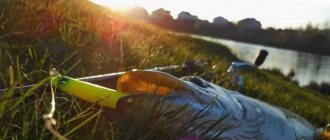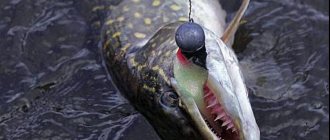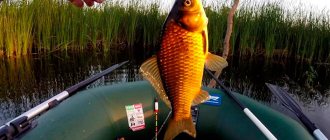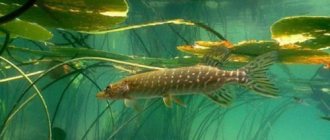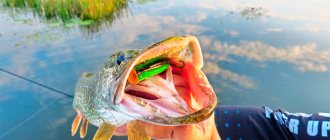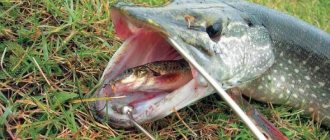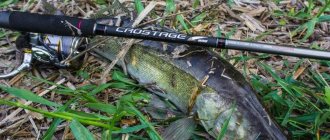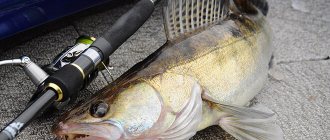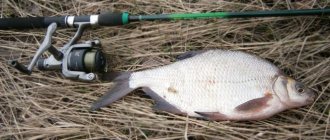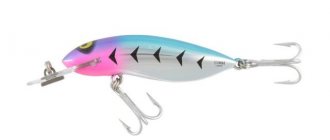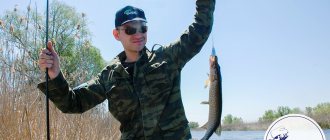Pike habitats in summer
Pike lives in almost all deep rivers. There she hides under snags, on sand spits, because there is plenty of food there, which helps her survive and reproduce all year round.
Snags are a place with submerged trees that have fallen into the water and slow down the water flow, forming an eddy with changes in depth. Sawdust accumulates in them, which provides additional cover for predatory fish and a place to live.
Thickets of grass are the second most popular place where fish like to spend the winter and live in the first half of summer. The fish actively hide and hunt here.
She also actively lives and hunts in the mornings and evenings on sand spits. The duration of the bite in such a place is no more than an hour, but due to the concentration of a large number of small fish, there are a lot of predators observed here. You can catch more than 10 pieces at a time.
Bridge areas are another favorite spot for pike. This is where small fish like to be, which they feed on.
Good to know! Backwaters with tributaries, all kinds of man-made canals, locks and dams are places where pike actively gather. They burrow in holes and hunt other fish.
Which baits should you choose?
Since the food supply of summer pike is quite large, it becomes more whimsical when choosing an object to attack. We can conclude that the predator will not respond to small baits, preferring larger objects. Therefore, using baits up to 5 centimeters, which worked perfectly in the spring, will be less practical than fishing with baits from 7 centimeters.
If everything is more or less clear with the size of the bait, then what type of bait should be chosen. It must be said right away that almost all baits, from a trivial twister to any type of wobbler, are suitable for catching a toothy predator. But when choosing a bait, you need to remember that the warmer the water becomes, the more sluggish the game of the device should be. At the beginning of summer, lures with high-frequency action and high retrieve speed work well.
Speaking of wobblers for the beginning of summer, the favorites in pike fishing are various shads and cranks.
The shad is a wide-bodied wobbler; its wide body creates stronger vibrations in the water due to uniform wiring.
Sheds for summer
Cranks - at the height of summer they really rule, catching pike many times better than twitching minnows. The game of the crank is strong, active, it creates strong vibrations in the water and attracts fish, sometimes even inactive ones.
In summer, try crank fishing. Or on a minnow with a strong own game.
Crank (Tsuribito Baby Crank)
On hot days, the situation with bait changes. And if at great depths you can use the same shads, then for shallow water you should choose twitching wobblers. They create movements with large amplitude and low vibration frequency during jerking, reminiscent of a wounded fish to a predator.
It is also important that the bait hangs in the water column as long as possible. Therefore, the use of suspenders is appropriate here. When choosing silicone baits for the hot period, you should pay attention to wide-bodied vibrotails. They glide longer as they sink to the bottom.
Wobbler-suspender
Broad-bodied vibrotail
By the end of summer, pike become less picky about bait. Therefore, at this time you can use a wide variety of wobblers, spoons, silicone baits, etc. Closer to autumn, you can also use large oscillating spoons.
Summer fishing gear
In the summer, pike can be caught with two types of gear: live bait and artificial bait.
Live bait is bottom tackle with a fishing line of great thickness and length, wound on a simple reel or reel. Thanks to the small sinker, the bait does not leave the hook and allows you to catch the predator using a single large hook or several doubles or treble hooks.
It all works like this: the fish eats the bait, swallowing it along with the hook, and moves towards the shelter; the moment the fish moves to the spot, the fisherman catches it.
Note! Artificial baits - spinning tackle with a 3-meter long fishing rod, a spinning reel and a supply of fishing line. Presented in the form of all kinds of circles, spinners, artificial soft fish and vibrating tails.
What gear do you need?
Spinning
Spinning is the main gear for catching pike in the summer. The power, length and action of the spinning rod are selected based on the fishing conditions.
Fishing from a boat may be more promising. The banks are often overgrown with impenetrable grass as tall as a person, and approaching the shore can be difficult. On a boat, you can always find an interesting place for fishing in any body of water - be it on a large river or in a “toad spot”.
Mugs
Mugs are an effective tackle for catching pike. Places with uniform depths and no snags are suitable for fishing with circles.
Zherlitsy
Zherlitsy are not as popular in summer as in winter:
- firstly, you have to cut out stakes, which can be difficult to stick into a hard bottom;
- secondly, in the summer it is more difficult to preserve live bait.
However, even in the summer there are fans of fishing with girders, both installed in the coastal zone and anchored at depth.
Donkey
Fishing with donkeys in summer can be effective if you throw the equipment into pools and holes. You can fish both with simple donks with a reel, and with tackle with a rod and reel.
Float
Float tackle for catching pike in summer should be powerful , i.e. include a large rod, a reel and a large, easily visible float. You can fish with float tackle both in still waters and in the current.
Trolling
Fishing for pike by trolling in the summer can be very productive, since the predator, especially the large one, often stays at considerable depths in the summer. When hunting for large pike, you can use large baits and tackle with multiplier reels.
Expert opinion
Knipovich Nikolai Mikhailovich
Zoologist, hydrobiologist. I am interested in fishing at a professional level.
Any equipment for pike must end with a leash. Materials that can withstand pike teeth are metal and thick fluorocarbon.
Lures for catching pike in summer
Catching pike in the summer is impossible without feeding and tackle. Animal baits are the most effective, but artificial baits are just as effective.
Animal baits
The best tenacious baits of animal origin are crucian carp. In summer, they can always be quickly caught in small bodies of water and used as a means of catching pike.
Moreover, she really loves crucian carp and often hunts them in real life. Roach is no less effective as bait. It’s rare that a fish doesn’t attack such live bait.
The only drawback is that roaches are stored in the basement for no more than 7 days. Perch is also a good bait for predatory fish.
Note! The sharp fins of a perch are not an obstacle for a predator, so she enjoys feasting on them with pleasure. The good thing about perch as bait is that the hook can be hidden on its back and the fish won’t notice it.
Artificial baits
Today, catching pike is not difficult thanks to the large number of artificial baits.
Commonly used as bait:
- Vertical spinner;
- Balance;
- Silicone bait;
- Pinwheel No3-6;
- Oscillator;
- Twister;
- Vibrotail;
- Foam fish.
The most effective of them are oscillating models. Thanks to its movement, the predator more actively pursues its target and remains more interested. Deep fish that live in grass thickets and snags may like spinners.
In hot weather, wobblers that work on the surface, right next to the aquatic vegetation, are effective. At the end of summer, jig baits in the form of twisters, vibrotails and foam fish are effective. They must be used in combination with stepped wiring.
How to catch pike in summer
Throughout the summer, the behavior of pike changes, so the angler constantly has to adapt to it.
June
In June, pike remain active only for a short time. The water gradually warms up, which leads to an increase in the amount of aquatic vegetation and a decrease in oxygen. It is most often caught with a spinning rod; the most preferred baits include poppers and noisy wobblers.
At the beginning of summer, pike prefer baits of white and red colors; deep wobblers and small spoons will be effective in holes and pools.
July
Perhaps the most difficult period for pike fishing. The activity of the fish noticeably decreases, and a lot of time has to be spent searching for the predator. In shallow waters, pike stop coming out, and in deep water it is unlikely to be encountered.
Therefore, the fisherman should first of all pay attention to shaded areas under steep banks, trees and bushes that cast shadows on the water surface. You can often find pike in heavily overgrown areas.
When preparing for such fishing, you should take into account the sluggish state of the predator. Therefore, they mainly choose small baits - in grassy areas, topwaters work well with a uniform, smooth retrieve. Small turntables also performed well. You can also fish with live bait using a float rod.
Pike fishing tactics in summer
- Tactics for catching pike in the summer come down to using different baits.
- It also comes down to searching for shaded places where fish may be found: thickets, snags, water lilies, shady places, bridge supports, quiet water near sides, bays and whirlpools.
- In addition to bait, you need to learn how to hook and land fish. This is the only way to achieve success in summer fishing.
Hooking and landing
Hooking and retrieving relatively small specimens is not difficult even for novice spinning anglers. Fast rods do not require a large amplitude of movement - a short hook is enough, and, conversely, slow rods require a sweeping hook.
In order for the hook to be successful and the predatory fish not to break off the hook, you need to keep the fishing line or cord in a state of tight tension. This can be achieved by coordinated work of the rod with the friction brake of the reel.
The spinning rod needs to be smoothly lifted up, and at this time the reel should be smoothly twisted, without giving any slack. If there is no resistance, this means that the fish is moving towards the person. In such a situation, you need to reel in the line and quickly try to restore the tension.
As for fishing, if the weight of the fish is low, you need to do forced fishing.
Lures: what is better to fish with?
For pike fishing today, an angler can choose what, in his opinion, will correspond to the mood of the predator and the fishing conditions. The choice is limited mainly by financial capabilities, and in the provinces also by the range of fishing products in stores.
Artificial
Spinners
Many anglers began their acquaintance with pike fishing with spinners, although those who fished at a time when spinning reels were not available used spoons as their first baits.
You should choose a spinner for pike based on the fishing conditions:
- So, for fishing in the current, baits with a heavy core and a petal like Aglia Long are suitable. It is better to fish at depths greater than 3 meters with the same spinners.
- In reservoirs where there is no current, you can also fish with spinners with a regular core and Aglia and Komet petals.
- For fishing in the water layer above thickets of vegetation, unloaded spinners like Mepps Lusox are effective.
- If you have to catch pike with a jig, then front-loaded spinners can replace silicone. True, they are too prone to snags.
For pike fishing, spoons No. 3-No. 5 are mainly used.
Hesitating
For fishing in shallow water, fairly wide, light spoons are used; for deep and current fishing, narrow and heavy ones are used. Some spoons catch fish not only on a uniform, but also on a stepped retrieve.
For fishing in the grass, non-hooking spoons are used. Spoons can be equipped with various devices to protect against snags, namely:
- single wire;
- two wire mustaches;
- wire loop.
Expert opinion
Knipovich Nikolai Mikhailovich
Zoologist, hydrobiologist. I am interested in fishing at a professional level.
You can attach a twister: single-tailed or double-tailed to a single unhooked hook. This improves the performance of the spinner and allows it to play attractively on the fall.
Wobblers
Wobblers have long been the favorite bait for many anglers. Since the advent of wobblers for jerking and twitching has become available, their popularity has grown even more.
Wobblers for pike fishing are divided into those that do not require any effort from the angler - they can simply be cast and dragged at one speed or another, since they have a pronounced game of their own. Such wobblers include all cranks and almost all shad-shaped lures.
Many minnow-shaped wobblers require jerking, with periodic pauses. Mastering twitch fishing is not so easy and requires specialized gear.
Wobblers vary in degree of buoyancy. The following options exist:
- floating wobblers;
- sinking wobblers;
- wobblers with neutral buoyancy or suspenders.
There are also intermediate options - slowly floating and weakly sinking wobblers.
In addition, wobblers differ in the degree of depth, which depends on the size of the nose blade of the bait and on the angle at which it is located in relation to its body.
Expert opinion
Knipovich Nikolai Mikhailovich
Zoologist, hydrobiologist. I am interested in fishing at a professional level.
The size of wobblers for pike fishing starts from 60 mm. The largest ones are 150 mm long. Wobblers that have their own game can be successfully used not only for casting fishing, but also for trolling.
Topwaters
Topwaters are floating baits that move along the surface of the water. Poppers, walkers, crawlers and torpedoes are used in clear spaces. Among the grass, the Croatian Egg popper-like bait and various frogs are effective. True, the percentage of bites sold when fishing with the latter is very low.
Silicone
Silicone lures when fishing for pike can be used as follows:
- As a bait on a jig rig.
- As a bait on a spaced rig. Of the “spaced out” rigs when fishing for pike, the most effective can be considered the Texas rig, used when fishing in snags and grass.
- As a bait on an offset hook (including a loaded one) when fishing in “toad beds”.
- As a bait on a weki rig when fishing in grass windows.
Silicone baits for pike fishing are twisters and vibrotails, less often worms and creatures. The size of lures depends on the activity of the pike and its size and can range from 2 to 8 inches.
Rattlins
Rattlins often replace jig baits, increasing fishing efficiency. To catch pike, you should use noisy baits, i.e. namely rattlins (rattlin' – rattle), and not silent VIBs.
Artificial flies
For pike fishing, craftsmen make special large pike flies , often with wire protection against snagging. Flies can be fished with fly fishing or spinning using a bombard or a retractable leash.
Spinnerbaits
Spinnerbaits were invented for bass fishing, but it turns out that our pike are extremely partial to them. Spinnerbaits are used for fishing in thickets of grass, since they are considered non-snagging, although no wire protection is provided. It is best to use spinnerbaits when fishing among sparse thickets:
- reed;
- reeds;
- horsetail, etc.
Natural
Natural bait for pike fishing is usually live bait. The following fish are used as live bait:
- crucian carp;
- perch;
- roach;
- silver bream;
- dace;
- gudgeon;
- loach etc.
Expert opinion
Knipovich Nikolai Mikhailovich
Zoologist, hydrobiologist. I am interested in fishing at a professional level.
Pike bite better on live bait caught in the body of water in which it is caught. If you bring live bait with you, then they must belong to the type of fish that lives in this reservoir. On the other hand, crucian carp is considered a universal bait fish, even if it is not a resident of the reservoir in which pike is caught.
Features of pike fishing in different months of summer
- In June, pike fishing is successful: the fish are active and catch bright baits well in shallow water.
- In July, fishing is less successful due to the heat: fish bite only on live or live-like baits, do not chase fast fish, so only a slow type of retrieve should be used.
- In August, fishing is extremely successful: the fish awakens their appetite and the excitement of chasing fast prey, so you need to use the appropriate gear. The principles of fishing in August do not differ from those in June, however, when it gets colder, you need to look for the predator closer to the bottom.
Baits and baits for pike in summer
Considering the fairly wide range of gear that is used for pike fishing, the variety of lures and baits is also very wide. The main feature of summer pike fishing is the use of small-sized baits.
If autumn pike fishing involves the use of baits of about 15-20 cm, then in summer it is advisable to reduce this size by 2-3 times. This is due to the passivity of the pike and its reluctance to chase larger and faster food.
The main spinning lures used for pike fishing in summer are:
- Wobblers;
- Rotating and oscillating spoons;
- Tackle with dead fish;
- Spinerbait.
When using live bait for live bait gear, the main rule is that the live bait must be from the same body of water where the fishing is done. In stagnant reservoirs, the best live bait will be roach, crucian carp, and rudd. In rivers, the best live bait will have a more elongated shape - bleak, spikefish, goby, gudgeon, perch.
An excellent live bait will be the narrow-bodied spiny fish, which lives in coastal vegetation. She lives on the hook for a very long time and constantly moves on it.
Recently, mandulas have appeared on the fishing market - bait for predatory fish. Try making a mandula with your own hands.
Experiments with bait and wiring
Summer pike fishing does not follow any rules or patterns, and one of the main techniques of summer pike is constant experimentation with baits and baits. Of course, every angler has his own assortment of baits that he considers catchy and in which he is confident.
Pike can be so capricious that sometimes a fisherman needs to try his entire arsenal of baits, and it is the last bait that the toothy predator will choose.
In summer, a large amount of grass grows at the bottom of the reservoir, which serves as an ambush for the toothy predator. In such places, she usually waits for schools of fry swimming by. As a rule, they are located near the shore and in shallow depths. The best baits will be those that can fish such places.
This is best done by various wobblers - minnows, shads, cranks. Considering the need to experiment with wiring, twitching, wiring with pauses, and even wiring can be options.
Light front and centrally loaded small spinners are also suitable for fishing such places with vegetation.
Catching pike with a rig with a dead fish
There are a large number of spinning anglers who prefer fishing with rigs with dead fish. This is explained simply - dead fish has a natural smell, appearance and taste.
In those moments when a predator is very picky and disdains all artificial baits, the tackle is the only spinning bait that can save the situation.
A very important point when fishing with a tackle is to use a dead fish from the same reservoir where the predator will be caught. It will be an advantage if you make several cuts in a dead fish so that it bleeds and also attracts a predator with the smell of blood.
Pike also loves the smell of salt , so it will be an advantage if the fish lies in salt for some time.
Different predators prefer different types of dead fish. Pike's competitor in the pond - pike perch - prefers narrow-bodied fish - bleak, goby, and the toothy predator prefers larger food - crucian carp, roach.
However, these types of fish have a soft body structure, so they have a poor hold on the hook and only last for a small number of casts. Perch and ruff are held most securely on the tackle, so using them you can make quite a lot of casts.
A spinning rod for fishing with a tackle must have a slow action. This is explained by the fact that the casting of the bait must be smooth, so as to minimize injury to the fish on the tackle during casting and hitting the water.
Fishing for pike with live bait
In the summer, when the passivity and lethargy of pike reaches its peak, it is advisable to catch the toothy predator with live bait. Live bait is a natural bait that, with its movement and smell, provokes a predator to attack.
All live bait gear intended for catching pike is designed in such a way that the pike, having grabbed the bait, begins to swim away with it and swallow it, and at the same time does not immediately feel the resistance of the gear.
The gear for fishing with live bait on the river is a girder. It consists of a slingshot, on which a rig in the form of a fishing line, a weight, and a hook with a hook is wound. Having grabbed the bait on the hook, the pike begins to swim away and unwind the fishing line from the slingshot. After a few minutes, when the bait is swallowed, the pike will sit firmly on the hook.
Another more universal tackle for fishing in oxbow lakes, channels and lakes are mugs. It is most promising to place mugs on the border of water lilies or other aquatic vegetation with an open body of water.
The advantage of circles, compared to girders, is the fact that they fish a larger area of the reservoir, swimming under the influence of the wind. The principle of operation of the circles is the same as that of the zherlitsa, only the zherlitsa tackle is stationary, and the circles can float throughout the entire reservoir. You can make zherlitsy with your own hands.
When biting, the circle turns over and begins to unwind the fishing line, releasing it to the pike, which swims away along with the bait. The fisherman, seeing the inverted circle, swims up to it in a boat and takes out his catch.
Another stationary tackle that is very convenient to use in windows between water lilies is a float rod. Considering the possibility of catching large specimens, the tackle must be very strong and reliable. The equipment must include a leash against pike teeth.
Fishing for pike with a spoon
Spinners, both oscillating and rotating, are less promising baits for catching pike in the summer than wobblers, rigs and live bait. However, given the fact that fishing does not tolerate exact rules and stereotypes, sometimes it is the spinners that shoot.
In the size of spinners, preference should be given to the minimum sizes, because small baits are more irritating to passive, sluggish and well-fed pike.
Among the rotating spinners for summer pike fishing, small spinners from well-known companies Mepps, Myran, Blue Fox, Kuusamo are perfect. These baits will have the greatest results when fishing the boundaries of aquatic vegetation and open water.
Of the oscillating spinners for summer fishing, the Meps and Abu Garcia Toby spinners are optimal. These spoons have a narrow body shape and a unique action.
non-hooking spinners in aquatic vegetation
At the end of summer, starting from the second half of August, you can use heavier rotating and oscillating spoons to fish holes and edges using jig fishing.
Here you will find a similar article about lures for perch.
Catching pike with a wobbler
The wobbler is one of the most promising spinning baits in the summer. Considering the versatility of this bait, you can fish with a wobbler in almost any promising area of the reservoir.
For fishing shallow places with vegetation on the bottom, riffles, near edges, and on the border with water lilies, surface wobblers and suspended wobblers are perfect. Excellent summer baits for such conditions are minnow-type wobblers and shad wobblers.
Examples of such wobblers are Jaxon Holo Select Karas and Yo-zuri Crystal Minnow.
To fish deeper parts of the reservoir, sinking wobblers are used, which fish the far edges and holes. An example of such a wobbler is Megabass Live-X.
Most modern wobblers are equipped with sound chambers, which, thanks to the sound effect, irritate the pike and provoke it to attack. Suspender wobblers have the ability to stop and hover in the water column, which can lure a very passive pike out of the grass and provoke an attack.
Fishing for pike with a popper
A popper is a type of wobbler that is designed for surface fishing for predators in windows of dense vegetation. Sometimes, in the sultry heat, pikes hide in grass shelters or in snags where there is no possibility of using any bait other than a popper.
The bait is passed along the surface of the water with twitches and pauses, making specific sounds. The noise that the popper makes, the splashing of water in all directions from the surface of the reservoir - all this imitates the hunt of a predator for a small fish that is running away from the predator.
Hearing familiar sounds, the pike tries to take part in this hunt and attacks the popper, without being able to get a good look at it.
Reviews from fishermen
I go fishing all year round with my friends. We especially like to fish for pike. It is well caught in winter near thickets and water lilies, but in summer you can also catch a couple of good carcasses. We fish in the village of Tikhotinskaya, not far from our country house. In the summer the bite is at least small, but you can always catch two or three pike in the morning with a few prepared crucian carp. Now I’m catching medium-sized pike, but I dream of someday catching a large one and taking a photo with it for my grandchildren. I use a spinner and a number 2 spinner and usually land 30 meters from the shore.
Grade:
Arkady, 50 years old, Volgograd
I often catch pike on the dead bottom. I fish with a green vibrotail in the shade of a tree every summer. In hot weather, somewhere around 30 degrees, it is not caught, but as it gets colder, you can catch a small one. Grade:
Anton, 34 years old, Starocherkassk
In summer I catch pike in a local reservoir from about 8 to 11 in the morning. These are the hours when the sun has not yet warmed up the water and it has not yet hidden from the heat. I fish with a regular spinning rod and live perch. It bites very well. It is important that the perch moves, then the predator is interested in catching it. I use a number 5 oscillator. Grade:
Vyacheslav, 27 years old, Chelyabinsk
I prefer paid fishing, with fed fish. I take a spinning rod, several types of gear and happily catch 2-3 pieces in 4 hours in the evening near the reeds. From my own experience, it is better to catch with live bait, such as perch or crucian carp. Grade:
Andrey, 44 years old, Moscow region
I’m not a fan of fishing, but from time to time I take a spinning rod and go to the Don to catch crucian carp, bream or pike perch. I use a vertical spoon, first I catch a small crucian carp, and then I try to catch a pike with it. It actively bites on this bait in the evening. Grade:
Mikhail, 30 years old, Novocherkassk
Let's celebrate! Fishing for pike in summer is no different in terms of effectiveness from fishing at any other time.
It is important to choose a cool place, use the right bait and fishing tactics.
Pike fishing is best near the thickets!
Fish areas near thickets of aquatic plants more often. You need to visit here several times a day. After the first unsuccessful attempt, try again later.
In the thickets, even if they seem absolutely lifeless to you, pikes are always lying in ambush. You can also fish from a boat, but then try to swim along the overgrown area. If it turns out that it is empty, make another attempt at the edge of the deep drop. Depending on the clarity of the water, in most cases you will find fish at a depth of 3-6 m.
Any bait is suitable for fishing from a drifting boat. What is more important is not the bait itself, but its wiring. Don't fish too deep!
A wobbler held at a depth of 2 m is more likely to be seen and attacked by pike than at a depth of 5 m. Pike prefers to attack from below rather than from above. The hooks on the wobbler are attached from below, so pikes attacking the bait from above are rarely detected.
Fishing spots
Rivers
Small
In small rivers, pike can live anywhere. The most attractive are river bends, whirlpools and areas under overhanging tree crowns, as well as places next to flooded snags.
Large
On large rivers, typical pike sites are the following:
- pits;
- exits from pits and entrances to them;
- channel edges;
- places with reverse flow;
- entrances to and exits from the riffle, and where the current loses its strength.
In addition to the indicated places where the main fishing method is jig, pike can be caught near coastal thickets, in various:
- backwaters;
- estuaries;
- spills.
Stagnant bodies of water
- Lakes . In large lakes, except for the coastal zone overgrown with grass, pike can most likely live on rocky banks and in holes. In small lakes, pike can be caught anywhere.
- Ponds . Since ponds usually do not have a pronounced relief, you can methodically fish the water area, changing baits in accordance with changing conditions.
- Reservoirs . Reservoirs almost always contain snags, in which you should try to catch pike. Areas near the main channel can also be promising for pike fishing.

